
North Sulawesi Diving
From Sorong we flew over the forested, mysterious-looking Raja Ampat islands before heading to the open sea. We passed over Halmahera, the largest island in the Moluccas, then just to the south of Ternate and Tidore, two of the main “spice islands”. After the wilderness of Papua, Northern Sulawesi appears intensely cultivated and densely populated.
As soon as we arrived in Manado, we started looking for liveaboards. We hoped to find a boat that needed two extra divers for a trip. After trying a few addresses with no luck, we managed to contact Rudi, who runs a boat called the Liburan. Before going straight to the liveaboard, Rudi advised us to dive a few days in Bunaken. Later we ran into Dan, who decided to accompany us to Bunaken and to the Liburan.
On Bunaken we chose Sulawesi Dive Quest. We spent two days exploring the nearby reef walls. The staff were technically competent, but not very enthusiastic about diving. Something was missing. On the afternoon of the second day, the staff from the dive center went off to play soccer. We decided to walk around the island to the eastern side for some snorkeling. We wandered into Bunaken Divers and started chatting with Terry, the owner. He saw an opportunity to get some new customers and offered us a better deal if we would switch to his place. It certainly was a world of difference: Terry was enthusiastic about diving and described in detail all of the great nearby sites. Convinced, we made plans to be picked up the next day.
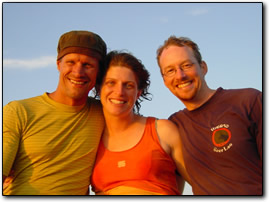 |
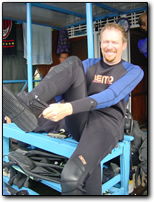 |
Diving was indeed better with Terry’s team. Our first dive was a wreck near Manado. Since we were still beginners, we couldn’t go all the way to the deep water at the back of the boat. Still, it was interesting to swim around the top part of the wreck and along the hull. For our second dive, Terry suggested a nearby site that, according to an underwater survey team, contains the highest number of coral species visible on one dive. It was incredible. That night we took flashlights and went on a night dive. We were both a bit nervous about diving in the dark, but it turned out fine. While the reef fish sleep in nooks and crannies in the coral, crabs and other strange creatures come out at night. The next day we went on an excursion to the Bangga Islands, north of the mainland. Here Eric spied a moray eel as big as thigh hiding in the rocks. He also saw a bat ray “flying” through the water, but Anne and Dan were too far away to get their attention.
After four days of intense diving, we decided to take a break. Anne was wiped out. We first thought it might be malaria, but it turned out to be nitrogen buildup. With Dan in town, we set off for the eastern side of North Sulawesi to Tangkoko national park. The tarsiers that are found there are the smallest species of primate. Nocturnal, with eyes so large that they cannot turn in their sockets, they live in small families in strangler-fig trees. We arrived at the park just before dusk, found a guide and followed him into the forest. He took us to a particular fig where the tarsiers were not afraid of people. When we arrived at the tree, the primates were already out. A mother and small baby crouched in a crevice, watching us intently. On the other side of the tree were another four. They hopped, jumped and climbed around the twisting body of the tree. One leapt to a nearby bush, caught a small grasshopper, and gobbled it up. They didn’t seem bothered by our flash cameras, so we took plenty of pictures.
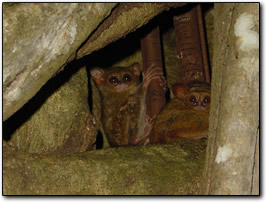 |
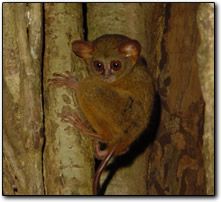 |
Rudi picked us up the next day and took us to the Liburan. Once the only “luxury-class” liveaboard in the area, today it was visibly showing its age. Next year a new, steel-hulled boat that Rudi was building would replace it. After renting dive gear from a nearby resort, we were ready to plunge. Liburan cruised the Lembeh Straits, one of the best places in the world for “muck diving”. Strange creatures live in the sand and mud below. The frogfish, looking like a four-legged monster, squats on the bottom, perfectly camouflaged, waiting to gobble up any fish foolish enough to be lured by its “dangler”. The world’s most poisonous fish, the stonefish, bristling with spines and with a face “only a mother could love” sits patiently, its diamond-like eyes peering into the water. A small hole in the sand might hide a brilliantly striped octopus, or a gaping eel. At night, the clownfish sleep, cradled in thousand-arm anemones, while moray eels slither about on the prowl. There are richly colored nudibranchs and fat, sand eating sea slugs. There is even a kind of bottom-feeder that looks like a piece of seaweed. Its waving tentacles contract like fists, stuffing food into the “mouth” at the center of its body.
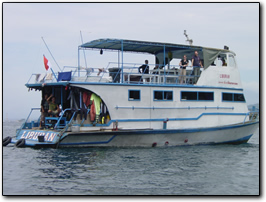 |
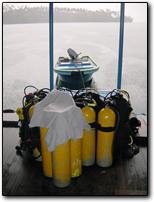 |
Rudi was an experienced dive instructor, gave us plenty of dive tips. Always check the seal on the tanks to make sure they are still safe. Don’t expect the dive master to assist you if you get into trouble. And, no matter what, stick close to your partner!
It was time to catch our flight back to Surabaya. The taxis all wanted an outrageous amount of money to take us to the airport, just outside of town. We boarded one of the numerous blue bemos that constantly cruise the streets of Manado. At one stop, when all of the other passengers got out, we asked the driver how much he would charge to take us straight to the airport. After a little haggling, he took us directly to the terminal. When we gave him a big tip, he smiled and drove off. In Indonesia, anything is possible!
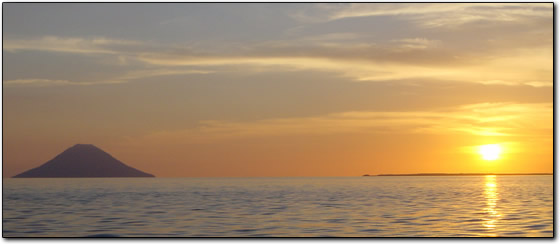 |
